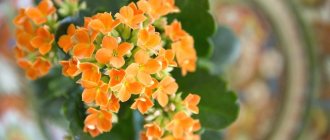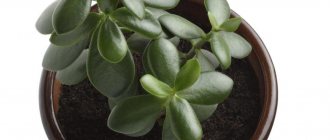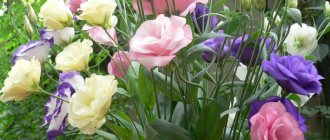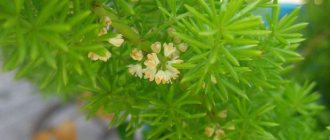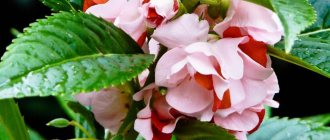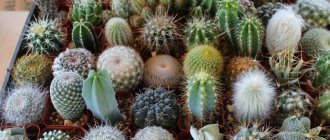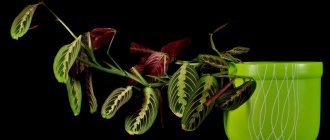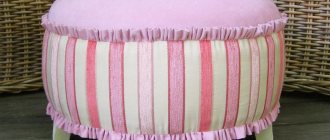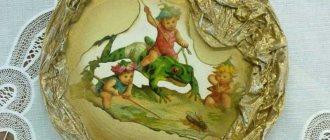The majestic begonia (one of the varieties was not called royal for nothing) is a unique flower. One of the few tropical plants, the species of which combine several different classes, begonia can climb like a vine, grow as a bush or a small leafy cap, and delight the eye with a variety of colors of buds or foliage. All this is begonia. Care at home - the photos speak for themselves: the flower is incredibly beautiful.
Begonia bush.
Begonia creeper.
Begonia blooming.
Begonia leaves.
Together with the portal agronom.guru, we will learn more about this exotic guest, talk about caring for the plant, the characteristics of begonia propagation, analyze the difficulties that can arise with improper care, and study the varieties of the flower with photos and names. The homeland of begonia is the hot tropics, or rather the Antilles. The plant was first found and described by the French biologist Charles Plumier in 1687. However, the exotic flower received its name thanks to the “sponsor” of the expedition, Michel Begon.
The Antilles - the birthplace of begonia
The main feature is abundant flowering all year round. Begonias “fall asleep” for a short time. And young plants with still unripe tubers can generally “boycott” the regime of winter sleep and rest.
Begonia is very popular among breeders. So much so that there are twice as many hybrid forms as decorative varieties. Of the three thousand known flower variations, two are hybrids.
They thrive in damp, shady places – in rock crevices and tree roots. Distributed in the subtropics of America, Southeast Asia and Madagascar and Hawaii.
Begonia in Hawaii.
There are types of flowers that are not afraid even of salt water. In the Philippines, begonias do well on limestone cliffs. In the Andes and Himalayas they can grow high above sea level. There are also succulent forms that absorb water into the tubers. There are artificially grown ones, for example, this begonia is shaped like a Japanese bonsai tree.
Begonia Bonsai Schmidt.
Begonia - brief botanical information
By type, begonias can be divided into annual and perennial. Plants are so diverse that it is impossible to describe all its characteristics. However, there are some features common to all begonias:
- leaf asymmetry;
Royal begonia leaf.
- bright flowers : white, yellow, red, pink, edging possible;
In terms of beauty and richness of its buds, begonia can compete even with the queen of flowers - the rose.
- the fruits , if not removed, have the shape of a box. In nature, this is how a plant reproduces - the film bursts and the seeds are carried away by the wind.
The seeds of some types of begonia are extremely small - there can be up to 75 thousand of them in one gram.
There are many types of begonia. There are evergreen varieties, there are deciduous, perennial and annual, outdoor and indoor, creeping and tall. In floriculture, the following classification is usually used: decorative deciduous and flowering. Types of indoor begonias, photos with names, let's look at them right now.
Types of decorative foliage plants: names and photos
This group contains those representatives of the large begonia family that are distinguished by unusual foliage. Decorative deciduous begonias, look at the photos and names.
Royal
Begonia Royal.
The homeland of this variety of begonia is India and Asia. Leaves of unusual shape and bright color. The veins of the leaves are usually lighter, the flesh is darker. The photo shows a variety of royal begonia - Rex.
Begonia rex.
In Russia, the flower discovered by the Frenchman was jokingly called “Napoleon’s Ear,” comparing it with the ears of the commander who shamefully fled from snow-covered Russia in 1812. Royal begonia (photos of varieties) in home care is a capricious plant, afraid of drafts.
Varieties of Royal Begonia.
The flowers here are more modest. High humidity is required. Caring for Rex begonia at home: the rhizome of the plant spreads along the top layer of soil, so a shallow but wide pot is suitable for the flower.
Tiger
Unlike its predecessor, tiger begonia is an artificially bred plant. This unusual indoor begonia flower, as in the photo, will become a decoration and natural ionizer for any apartment.
Tiger begonia.
The leaves have a specific color, from a distance reminiscent of a tiger, with white fluff on the edges. Quite a compact flower. Tiger begonia at home requires some care; the photo shows a rare flowering of tiger begonia.
Tiger begonia blooming.
In order to ensure bright and deep color of the leaves, it is necessary to remove the flowers from begonias of this type. Then all the strength of the plant will go into the growth of leaves. The same is done with old leaves.
Cleopatra
Belongs to the type of bush begonias. The flower is long-lived; with proper care, the age of the plant can reach 4-5 years.
Begonia Cleopatra.
To increase the lifespan of begonias, “rejuvenation” is necessary - annual division of the bush. This is usually done in the spring, when the plant is replanted or cuttings.
Cleopatra is a miniature flower of an interesting color. The leaves are fluffy with light fluff, resembling frost from a distance.
Coral
This type of begonia is one of the hardiest plants. It has strong leaves and a thick, bamboo-like stem. This begonia is loved because it is tolerant of drying out, precisely because of its “margin of safety.” Here the flowers look like bunches of barberries.
Coral begonia.
The flower grows up to one meter in height and has paired leaves. It grows very quickly, as in the photo. If you provide coral begonia with proper care at home and a favorable climate, it can form a beautiful, voluminous bush up to half a meter wide. It is very important to choose the right container for the plant. It should be spacious enough to accommodate a massive rhizome; it is better to choose a clay pot. Such “dishes” heat up evenly and provide the plant with the desired temperature.
Metal
Metallic begonia.
The metallic begonia plant (photo above) received its name due to the specific grayish tint of the leaves. The stems of the plant branch well and have a dense structure. It grows more than a meter.
Begonia hogweed
Hogweed begonia.
Reminds me of hogweed leaves. Beautiful, dense pink stem, massive leaves with veins. An unpretentious plant with an extensive crown.
Begonia cuff
Cuff begonia.
The leaves are collar-shaped - pointed and elongated. The stem is quite fleshy with red fibers. Grows up to one meter. There is a darker variation of the plant - the black prince. Its leaves look like velvet.
Cuff begonia "Black Prince".
Types and varieties
There is no single established classification of begonias today, but in the specialized literature one can find conditional options for dividing begonia species, for example, into decorative-deciduous and decorative-flowering or, for example, division according to the characteristics of the underground part - into rhizomatous, tuberous begonias and begonias with superficial root system. Some prefer to divide the species of this plant into the following groups: decorative deciduous, bushy and tuberous.
But recently, begonia species are more often divided into:
- bushy begonias with bamboo-like erect shoots;
- begonias with thin and flexible drooping or creeping shoots;
- species with thick rhizomatous lodging or lying shoots;
- species that are the ancestors of beautiful flowering hybrids.
In indoor floriculture, it is more convenient to use the following classification of begonias:
- decorative flowering indoor begonias;
- decorative deciduous indoor begonias;
- decorative flowering potted begonias.
We offer you the names of the types of begonias most common in indoor culture, with their brief descriptions, as well as the names of the varieties of begonias belonging to these species. Deciduous begonia, or leaf begonia, in indoor floriculture is represented by the following species:
Royal begonia (Begonia rex)
The plant is native to Eastern India. This is one of the most beautiful begonias, on the basis of which numerous decorative deciduous varieties and hybrids have been bred. It has a thickened rhizome and beautiful, large, bare or slightly pubescent leaves up to 30 cm long and up to 20 cm wide, asymmetrical heart-shaped with wavy or unevenly jagged edges of bronze-brown, velvety crimson or red-violet color, which are sometimes decorated with red-violet or silvery spots.
There are hybrids with almost black leaves with crimson spots. This species blooms with inconspicuous pink flowers.
The best varieties of royal begonia:
- Cartagena is a variety with dark green rounded leaves wrapped in a shell. The dark brown center of the leaf becomes plum-colored as the plant matures. The green background of the leaf is covered with silvery spots with a pinkish glow;
- Silver Greenheart is a plant with silvery, obliquely heart-shaped leaves with an emerald green border splashed with silver;
- Chocolate Cream - the middle of the spirally twisted sheet of this variety has a juicy plum shade, and the main part of the plate is silver with a pink tint;
- Evening Glow is a variety with medium-sized leaves with a bright crimson center, from which greenish-brown veins radiate across the crimson field. The edge of the leaf blade is crimson;
- Hallelujah is a variety with large, spirally twisted leaves at the petioles, soft purple leaves with a silver tint. The center and edge of the leaf blade are cherry-colored, and between them there is a wide bright green stripe, completely covered with silvery spots.
In addition to those described, the following varieties and hybrids of royal begonia are popular: Lilian, Pearl de Paris, Red Tengo, Regal Minuet, Titica, Silver Corkscrew, Benitochiba, Black Fang, Deudrop, November Frost, Charm and many others;
Tiger begonia (Begonia bowerae)
Or Bauer's begonia, or maple-leaved begonia, is native to Mexico. This is a low plant - it reaches no more than 25 cm - with a creeping stem and light green leaves with black or brown spots along the edges. The underside of the leaf blade is pubescent. Light pink, inconspicuous flowers are collected in drooping, loose inflorescences. This species is rare in nature, but thanks to hybridization carried out by breeders, many very spectacular varieties have been developed.
- Phalaenopsis: how to water, fertilize and replant
The best varieties of tiger begonia:
- Tiger is a plant with a creeping stem, reaching a height of 10 cm. The leaves are velvety, bronze with a pattern, along the veins there is a brown stripe, the petioles are reddish, spotted;
- Cleopatra - this variety has leaves covered with light hairs that change color depending on the lighting, the underside of the leaf blade is red or burgundy.
Coral begonia (Begonia corallina)
A semi-shrub plant from the tropical forests of Brazil, in indoor conditions reaching a height of about 1 m. The stems of this species are erect, bare, resembling bamboo. The leaves have serrated edges, oblong, ovate, up to 20 cm long and up to 7 cm wide. The upper side of the leaf blade is dark green with silver spots, the lower side is light green. Flowers on coral peduncles are collected in racemes.
The most famous varieties:
- Alfalfa is a plant with large green leaves with jagged edges, covered with silvery spots on the upper side of the leaf. The underside is red;
- President Carnot is a variety with shield-shaped leaves dissected at the base of the plate with a slightly toothed edge. Leaves are up to 30 cm long, up to 15 cm wide, with whitish spots on the green background of the leaves.
Caroline begonia (Begonia carolineifolia)
One of the oldest indoor plants, imported from Mexico. It has a creeping stem about 4 cm thick and large, palmately dissected leaves up to 35 cm long, with obvious venation, located on yellow-green petioles. The flowers are greenish-pink, collected in loose racemes, open in February.
In addition to those described, the following types of decorative deciduous begonias are in demand in culture: Mason, striped, hogweed, metallic, white-spotted, Bovera, red-leaved, yellow, Limminga, brilliant, imperial and many others.
Decorative flowering species of begonia in indoor culture are:
Begonia semperflorens
A small bush-like plant reaching a height of 60 cm with erect shoots when young, and in an adult plant they take an ampelous or semi-ampeloid shape. The leaves of begonias of this species are round, slightly pubescent along the edges, up to 6 cm long, light green, dark green, sometimes with a reddish tint. Simple or double flowers of white, pink or red, up to 2.5 cm in diameter, are collected in short-lived inflorescences that quickly fade, but are immediately replaced by other flowers.
If you provide good care for your ever-flowering begonia and provide it with the necessary lighting and nutrition, it can bloom in winter.
The best varieties of this species are:
- Gustav Knaake - a spreading bush up to 30 cm high with green leaves with a red outline and bright carmine flowers up to 3 cm in diameter, collected in inflorescences;
- Carmen is a medium-sized begonia with brown leaves with anthocyanin and numerous pink flowers;
- Ambergris is a plant up to 15 cm high with brown leaves and pink flowers up to 3 cm in diameter;
- Bikola is a bush up to 14 cm high with green leaves and white flowers with pinkish edges;
- Orania is a compact bush up to 16 cm high with green leaves with a red edge and orange-red flowers.
Varieties of ever-flowering begonia Leila, Bella, Lucifer, Rozanova, Scarletta, Linda, Albert Martin, Ball Red, Othello, Kate Teicher and others are also grown in cultivation.
Begonia x elatior
This is the brightest and most abundantly flowering hybrid plant, an absolute favorite among indoor begonias. It reaches a height of no more than 40 cm, it has a fleshy thick stem and alternate heart-shaped leaves up to 8 cm long with a jagged edge. The upper side of the leaves is glossy, bright green, the lower side is matte and lighter. Flowers are collected in inflorescences on long peduncles.
The most famous varieties:
- Schwabenland is a tall variety that blooms profusely with small bright red flowers;
- Renaissance - double begonia, tall, red flowers with ruffled petals;
- Louise is a variety with light cream flowers with a pinkish tint:
- Piccora is a low-growing begonia with double flowers of a bright pink hue;
- Rose is a variety with dark pink double flowers.
Also popular are the varieties of begonia elatior Sharlach, Kyoto, Cleo, Goldfinger, Annebelle, Azotus, Bellona, Berlin and others;
Begonia x tuberhybrida pendula
It is often grown in gardens and for decorating terraces and balconies. It is characterized by drooping shoots descending in cascades with numerous flowers. Ampelous begonias are grown in hanging flowerpots, baskets and pots. Among this group of begonias there are varieties with simple, semi-double, double and densely double flowers in white, red, pink, yellow and orange, as well as all sorts of combinations thereof. Flowers can be small, medium-sized or large.
We offer you several of the best varieties of hanging begonia:
- Gale is a spreading bush with long hanging shoots up to 30 cm long with jagged green leaves pointed at the top and semi-double pale pink flowers up to 3 cm in diameter;
- Christie is a spreading bush with weak hanging shoots up to 40 cm long and white double flowers up to 4 cm in diameter;
- Roxana is a compact bush with hanging shoots up to 40 cm long with orange double flowers up to 4 cm in diameter;
- Kati is a spreading bush with weak shoots up to 30 cm long with semi-double yellow flowers up to 3.5 cm in diameter.
Among decorative flowering begonias, the following hybrid varieties are popular today:
- Harlequin is a large-flowered variety with a spreading bush up to 25 cm high with green leaves and double flowers up to 12 cm in diameter, yellow with a red border;
- Gold Dress is a semi-spreading variety up to 25 cm high with light green leaves and pink, dense yellow flowers up to 20 cm in diameter;
- Duck Red is a semi-spreading bush no more than 16 cm high with bright green foliage and dark red double peony-shaped flowers up to 10 cm in diameter with wide petals;
- Camellia Flora is a compact bush up to 25 cm high with green leaves and pink camellia-shaped flowers up to 12 cm in diameter with tiled petals with a white border;
- Crispa Marginata - a bush up to 15 cm high with green folded leaves with thin purple ropes and white flowers up to 12 cm in diameter, wide oval in shape with a bright pink border and strongly corrugated wavy side petals;
- Ami Jean Bard - a bush up to 12 cm high with small green leaves and inflorescences of 5 double orange flowers up to 3 cm in diameter;
- Diana Vinyard is a compact begonia up to 20 cm high with light green foliage and densely double white flowers up to 20 cm in diameter with folded wavy petals;
- Marmorata is a semi-spreading bush up to 20 cm high with double scarlet flowers up to 12 cm in diameter with white streaks;
- Feuerflamme is a bush up to 20 cm high with green leaves with crimson veins and semi-double flowers up to 3 cm in diameter, orange-pink.
Types of decoratively flowering indoor begonia: names and photos
These plants are an excellent choice for a home flower garden. Ever-blooming begonia is easy to care for at home. Photos of plant varieties.
Begonia everblooming
Begonia Semperflorence.
Ever-blooming garden begonia.
Begonia ever-blooming terry.
Such begonias do not stop flowering almost all year round. The leaves are usually dense, small, oval in shape. In order for the plant to withstand the pressure of the buds, small wooden sticks are usually inserted into the soil, as in the photo.
Supportive procedures for ever-flowering begonia.
Caring for evergreen begonia at home involves periodic rejuvenation and replanting by cuttings.
Ampelnaya
This type of begonia is often used in landscape design. She looks great in a flowerpot.
Ampelous begonia in a flowerpot.
Ampelous begonia is used to decorate steps and stairs, as well as gazebos. The plant has curly flowers that create a voluminous and branched structure for the entire plant. The flower belongs to the category of tuberous flowers; in the photo there is a hanging begonia before planting.
Tuber of ampelous begonia.
The best time to plant a new plant is from February to April. It is during this period that daylight hours are optimal for tuber germination, and the sun's rays are not scorching.
Rules for planting hanging begonias: step-by-step instructions with photos
Let's take a tuber we already know. They are sold at any flower shop. When you buy a flower, pay attention to its density and elasticity. You cannot take hard tubers, they have lost the necessary moisture and will not germinate! On the way from the store, do not freeze the planting material.
| Photo | Actions |
| We pickle our tuber with special preparations - Maxim summer resident, Vitoros, Fitosporin. Dissolve according to the norm. The drug has a caustic, poisonous color so that you will never confuse it with any other liquid. You can hold it for 20 minutes. This will prevent our plant from fungal parasites that may have appeared during transportation. | |
| It is necessary to plant with the concave part up. These tubercles are the remnants of the previous stem; it is from here that the first buds will come, and then the sprouts. | |
| We prepare the containers. Our soil is disinfected with gleokladin. You can add trichoderma mushroom. The soil is quite wet. We remove some of the soil from the pots. | |
| In the sun, begonia dries out very quickly, so in order not to water it every day, we add hydrogel. This hydrogel should fill the container by about 1/3. This viscous substance absorbs excess moisture, and then portions it out to the flower, thereby ensuring such passive watering. Once the hydrogel is laid, you can water it. | |
| We fill in the remaining soil, but not completely. Because when stems form from these tubers, they will rise, and soil will need to be added to them. | |
| We deepen it just a little bit so that these “shoulders” of tubers remain on the surface. There is no need to do anything else, since our kidney was moistened with geoclodine in advance, plus we added hydrolell. The plant needs to “breathe” in the open air | |
| This is what our sprouts look like after a month. When they first appear, it is better to sprinkle them with vermiculite. This material is similar to sand. It prevents rot from developing near the root collar and helps to avoid its overmoistening. |
Ampelous begonia - features of care at home in winter
In winter, ampelous begonia does not bloom. However, due to the lush green “tent”, it looks quite good. It is important not to overwater the plant during this period. In addition, it is necessary to ensure sufficient lighting. If daylight hours are short, it is better to consider additional lighting. In winter, the main danger for begonias is drafts and temperature changes! From February, grown leaves need to be trimmed.
Elatior
The flower is a hybrid, the result of a “close friendship” between tuberous and Socotrans begonias.
Features of caring for begonia Elatior at home
Almost a greenhouse plant. Afraid of temperatures below 20°C and drafts. The shoots are quite fragile, so, as we have already shown, it is better to support the flower with a high pot or sticks.
Begonia Elatior.
Begonia Elatior Rebecca.
Two-color inflorescences of different shades delight lovers of fragrant beauty until late autumn.
IT IS IMPORTANT TO KNOW!
Periodically cutting off flowers will help stimulate active flowering.
For active flowering, the plant needs rich daylight, but it should not be placed in direct sunlight. This may burn the leaves. However, too much shading may result in the flower not blooming at all.
Fimbriata
Sometimes it is called velvet, it looks like a terry towel. The flowers are quite lush. Needle-shaped, a little like carnation flowers. A particularly favorite variety is Fimbriata yellow.
Begonia fimbriata.
Velvet begonia. Such plants are not inferior in beauty to chrysanthemums and roses. Begonia Fimbriata yellow is easy to care for and can be planted in open ground.
Picoti
It features an interesting two-tone color. The process of active flowering of each bud can reach three to four weeks. Flowering usually begins in late spring. It belongs to the type of tuberous begonias; the photo shows how unusual the color of this flower is.
Tuberous begonia Pikoti.
The rest period for this begonia begins with the arrival of autumn. It is better to pick even ripe buds at this time in order to leave strength to the leaves.
Catalog of indoor flowers with photos and their names. In a special publication on our portal we will talk in detail about indoor flowers. You will learn about types of indoor flowers, about fruit indoor flowers and get acquainted with a detailed photo gallery.
Planting begonias
Tuberous begonia seedlings are planted in open soils in early June. Before planting, the seedlings are hardened off by placing them for 5–8 days in a bright room, where the temperature is maintained at +23…+27°C during the day, and +12…+15°C at night. To plant tall begonias, the holes are placed at a distance of 35–40 cm from each other; for low-growing varieties, 15–20 cm is sufficient. If you plant low-growing begonias in hanging containers, then a distance between the holes of 8–12 cm is sufficient.
The depth of the planting hole depends on the size of the seedling, but you need to take into account that the stem of tuberous begonia is unusually fragile and breaks easily. Therefore, deepen the hole taking into account that the base of the stem is also covered with earth.
Before planting, the hole should be thoroughly watered with potassium-phosphorus fertilizer. The southern charmer loves fertile soils, the ideal soil substrate for her is: leaf soil, humus, sand and peat, in the proportion: 2:1:1:1. After planting, the ground will need to be sprinkled with ash or humus. If the nights are cool, cover the seedlings overnight.
How to care for begonia at home
First of all, you need to take care of where the plant will be planted. The best option is a ceramic pot with a drainage system.
The best container for begonias is a ceramic pot.
This container will allow the plant to breathe and retain heat well.
REMEMBER!
The pot must be chosen so that, taking into account the root system, the plant is covered by another 4 cm of soil. A pot that is too spacious can lead to stagnation of excess moisture and rotting of the roots.
Soil selection
It is better to choose slightly acidic soil with a small amount of peat for begonias. A universal primer will also work. However, it needs to be given additional looseness. For this you can use vermiculite, perlite or coconut fiber.
IT IS IMPORTANT TO KNOW!
Before transplanting, the soil must be disinfected. This can be done in the oven at a temperature not exceeding 60°C.
Soil preparation.
Option for soil composition for begonias: equal parts sand, peat and rotted mullein. Or part of leaf soil, the same amount of coniferous soil and the same amount of sand.
Temperature and humidity
The ideal temperature for begonias is from +21 to -28°C. If the temperature problem is more or less solvable, but with humidity it’s more and more complicated. The easiest option is to use humidifiers. The most plausible (you can’t put a humidifier on every window) are pallets with expanded clay.
Plant moisturizing option.
Expanded clay must be constantly moistened.
But begonia leaves don’t like moisture! Do not spray them with water under any circumstances!
The water from the expanded clay will evaporate, and the humidity around the flower will increase.
Optimal lighting
The plant loves light, especially its flowering species. But the difficulty lies in the fact that when exposed to direct sunlight, the delicate leaves of begonias can get severe burns. The plant feels best on the eastern and western sides of the premises. If it is not possible to rearrange the plant, then shade the windows or cover them with film or paper.
Watering and fertilizing
The plant loves water. However, it must be remembered that excess moisture is detrimental to the root system. It is necessary to water only when the soil has dried out at least one and a half to two centimeters. And this depends on the conditions of detention and the season. In winter, watering is reduced, and tuberous species are cut off and placed in peat.
Begonia on the windowsill.
It is important to take into account the weather and humidity. If you plan to leave, hydrogel will help a lot. We talked about how to use it earlier. The bottom line is this: it retains moisture and gradually, as the soil dries, releases it. If there is no hydrogel, drainage can be used.
During flowering periods, fertilizing can be carried out at least every day; to do this, dilute the fertilizing solution in the watering container twice as weakly as usual. Then feeding the plant will not seem stressful to it. Any mineral fertilizers are suitable for these purposes. There are special ones for different types of begonias.
For flowering types of begonias, nitrogenous fertilizers cannot be used; they inhibit the formation of buds!
Transfer
Transplantation is a necessary condition for the long life of a plant. First of all, it is carried out immediately after it enters your home. Most often, purchased varieties are planted in soil that is not intended for this purpose.
The general procedure for transplantation is:
- Water the plant generously. This is necessary in order to remove it from the mold more painlessly. We wait a day so that the plant is not wet, but slightly damp.
- We decorate the pot. To do this, drainage is placed in the prepared container. Next - 3 cm of charcoal.
- We replant the plant, adding soil around it. At this stage, it is important to free the rhizome from the old soil.
- After this, the flower must be watered.
- During the first month, the flower will adapt to new conditions. You should be especially careful at this time. Avoid temperature changes and drafts, as well as overheating of the plant.
It is best to replant a houseplant in mid-March. It is at this time that there will be enough sunlight for the flowers.
If you have questions about planting tuberous begonias at home, watch the video:
Features of winter care for begonias
Tuberous begonias must be pruned. It is necessary to leave only 4 cm. The tuber is dug up directly with a lump of earth and placed in boxes for storage.
Pruning tuberous begonia for the winter.
The first stage is drying the roots, the second is pruning the shoots. The tubers will wait for spring. It is important to observe storage conditions: temperature not lower than +10°C, and obligatory darkness. The features of caring for begonia in winter at home for ever-flowering types are no different from other plants; it is important to ensure uniform, moderate watering.
How to care after the begonia has bloomed
The flowering period ends with the onset of the first cold weather. Withered buds, dry leaves, and shoots directed inward are removed. This allows you to rejuvenate the plant. Plants should be trimmed with a clean, sharp knife, and the cut areas should be sprinkled with activated carbon or wood ash.
You can admire the flowering of begonia for a long time, but for the beauty of the plant it needs a little help by providing the right growing conditions. Maiden's beauty, as begonia is also called, is unpretentious, but ignorance of some nuances can negatively affect the growth and number of flowers.
How does begonia reproduce?
Reproduction from a tuber
The most common way to propagate begonias is by tubers. The tuber is divided into several parts so that each piece contains a bud. Next, plant it in moist soil, cut side down. Cover with plastic wrap and place in a warm place. When the begonia gives roots, the film is removed and the plant is transplanted into a separate pot.
Reproduction of begonia from leaves
Let us consider the stages of the process of begonia propagation at home by leaf in more detail.
| Photo | Actions |
| Prepare a container for watering - add phytosporin M. Universal powder against diseases and fungi, Volume - on the tip of a knife in a 200 ml container. The water should be warm, not cold. | |
| You can take any leaves, even from one of them you can get a lot of “babies”. We choose only juicy, well-formed and healthy begonia leaves. | |
| Young plants are not suitable. The following veins should be formed on the back side of the leaf. In young leaves they are much less pronounced. | |
| Cut the leaf stalk with scissors. Using a scalpel or razor, make small cuts across the veins closer to the base of the leaf. | |
| We moisten the soil in the prepared container with soil. You can add a little phytosporin to the water. Lightly press into the soil. | |
| Place the sheet with the back side down in the prepared container with soil. | |
| We put a “weighting agent” on top. This could be a small pebble, buttons, a decorative ornament, or a regular eraser. | |
| Cover the plant with film so that it is exposed to the light, but not in direct sunlight. Remove the weighting material after 4–5 days. | |
| Cuttings take root within 15-20 days. During this time, you must not remove the cover or touch the seedlings. When a young plant appears, it needs to be ventilated. | |
| After strengthening the rhizomes, the plant is transplanted into separate containers. |
From seeds
This type of reproduction is considered the most ineffective. Seed germination rate is too low. And this process takes more time. Begonia seeds are sown in prepared soil in winter. The container is not covered with soil, but simply carefully sprayed with seeds and covered with film.
Propagation of begonia by seeds.
Once a day, open the container for ventilation. After the third leaf appears, the begonia is pruned. After a couple of months, a transplant and re-dive are carried out.
Propagation of begonia at home by cuttings
Transplantation by cuttings is used when a lot of transplanting material is needed. But it requires special caution.
Begonia cuttings.
Begonia after transplantation.
It is important to remember that not all types of plants can be propagated in this way. Typically, this method is used in bush species.
Usually a cutting with two buds is chosen. The cut area is usually sprinkled with charcoal. Place the stem in a pot with soil. To do this, you need to make a hole in a container with soil with a stick, the depth is up to the leaves. Then we cover the cuttings. Within a month the plant will produce its first leaves.
Dividing the bush
For bush begonias, a type of division such as propagation by rhizomes is also suitable. To do this, we free the plant from the soil, examine the roots, wash them with potassium permanganate, remove rotten and weak areas, and divide the rhizome so that each has a bud or sprout. As always, we treat the cuts with charcoal. Next is replanting into the ground.
Reproduction and transplantation
Begonia reproduces very easily in indoor culture. There are many ways to reproduce it:
- Sowing seeds;
- Cuttings;
- Dividing the bush;
- Reproduction by leaf blade;
- Propagation by tubers.
Indoor begonias are propagated by seeds extremely rarely. This method is long and very labor-intensive. It is much easier and faster to obtain a decorative plant using vegetative propagation methods.
For propagation of all types of plants, cuttings are used. Apical and stem cuttings take root and grow equally well. They do not require treatment with root growth stimulants.
It is only important that the cuttings are at least 7 cm long and have 3-4 leaves.
Root cuttings in water and soil. For rooting in the ground, use a flower pot with a moistened substrate. The cutting is covered with a glass jar and opened daily for ventilation.
For rooting in water, use boiled water at room temperature. After the formation of roots about 5 cm long, the cuttings are planted in the ground.
The division of the bush is carried out when transplanting overgrown specimens. They are divided into 2-3 parts. Each division should have several shoots and part of the root system. Delenki are planted in separate pots.
Begonia propagates very easily by leaf. Both the leaf with the petiole and the leaf blade are used. A leaf with a petiole is rooted in the same way as a cutting. After the roots appear on the cut petiole, children are formed, from which young plants develop.
When propagating with a leaf blade, it is laid on the ground, cutting the veins in several places. The pot is covered with film or a jar. In the places of cuts, roots are formed first, and then children and young plants.
Only tuberous begonia varieties are propagated by tubers. For propagation, large tubers are divided into parts.
Replanting an indoor flower is carried out as necessary if the root system has grown too large or the soil has become very depleted. Young plants are replanted every 1-2 years, adults - every 3-4 years.
Transplantation is carried out in early spring before growth begins. Begonias are not specially pruned. If overgrown bushes have lost their decorative shape, it is recommended to trim long shoots.
Possible problems and care errors
Begonia, like any flower, gets sick mainly due to errors in care. How to grow healthy begonia - let's name some mistakes and ways to solve them.
Begonia doesn't bloom
Usually the reason is an incorrectly selected fertilizer. If it is nitrogenous, then the process of bud formation will naturally be greatly inhibited. This type of fertilizer is suitable for deciduous types.
Begonia Bauer.
Another option is the wrong place for the plant, or the wrong temperature. The solution is to move the flower to another location and change the type of feeding.
Flower buds fall
The plant is experiencing stress. This usually happens in three cases:
- Excessive soil moisture.
- Wrong place.
- Excess fertilizer.
The solution is to find the cause and eliminate it.
Leaves turn yellow and curl
Sick begonia.
This is a symptom of soil depletion or drying out. Perhaps pests have appeared in the roots; to do this, they can be rinsed in a solution of potassium permanganate. Leaves turn black from excess moisture. The fragility of the plant indicates a lack of moisture or nutrition. Pale – lack of light. If the flower stretches upward, then it does not have enough sun, it spreads or crumbles to the sides - it is too dry.
Rot in the soil or at the base of the flower
This is one of the manifestations of a serious problem - pests have infested the roots and soil. This problem usually occurs if the plant is over-watered. Leaves with plaque must be moistened and the soil must be completely replaced. The flower must be treated with a fungicide. Other parasites include aphids and mites. In this case, begonia is treated with corocidal and insecticidal preparations.
